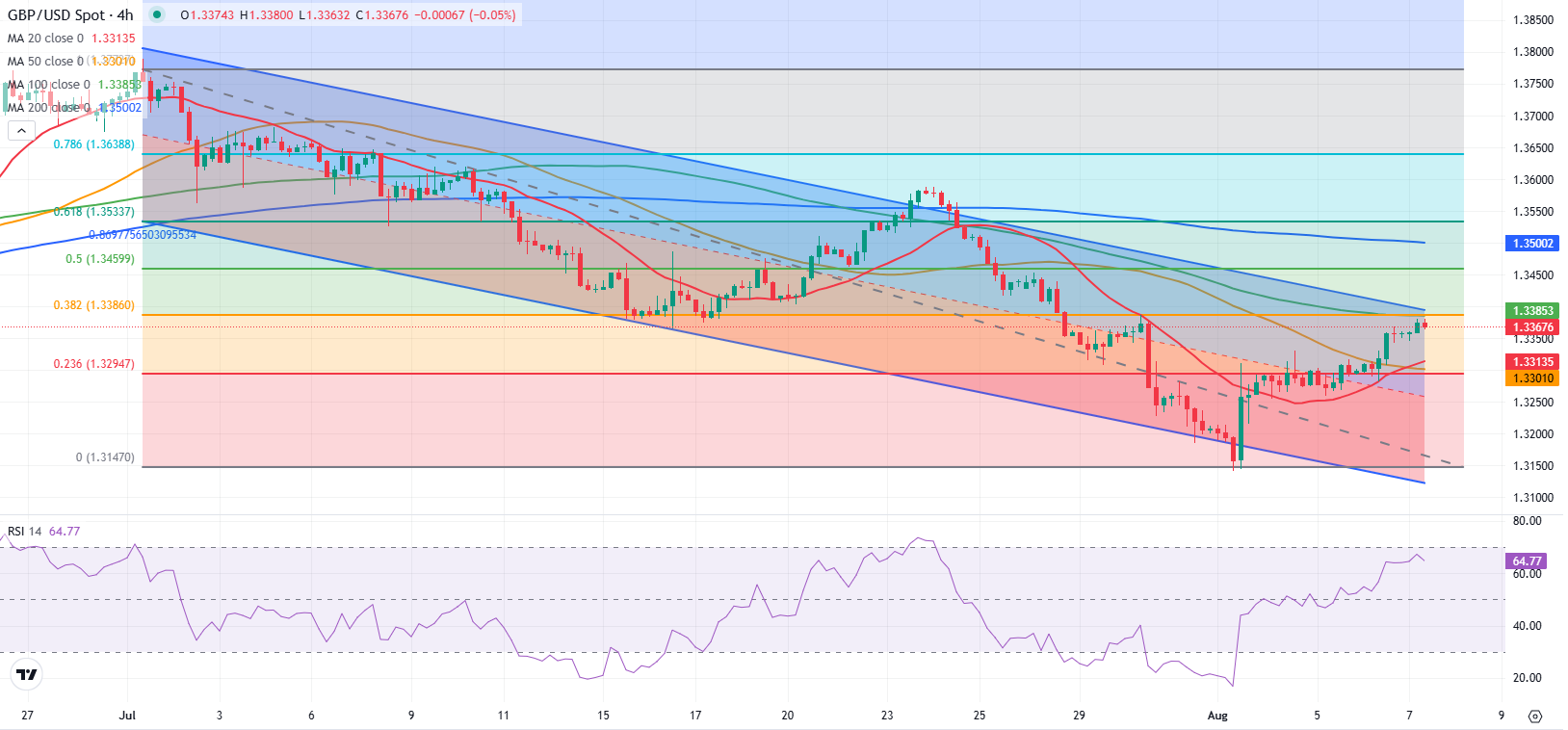
- GBP/USD trades above 1.3350 in the European session on Thursday.
- The BoE is widely expected to cut the policy rate by 25 bps.
- The technical outlook points to a bullish tilt in the near term.
GBP/USD holds its ground and trades above 1.3350 after posting strong gains on Wednesday. Investors stay on the sidelines while waiting for the Bank of England (BoE) to announce monetary policy decisions.
British Pound PRICE This week
The table below shows the percentage change of British Pound (GBP) against listed major currencies this week. British Pound was the strongest against the Swiss Franc.
| USD | EUR | GBP | JPY | CAD | AUD | NZD | CHF | |
|---|---|---|---|---|---|---|---|---|
| USD | -0.74% | -0.62% | -0.01% | -0.35% | -0.78% | -0.77% | 0.15% | |
| EUR | 0.74% | 0.16% | 0.74% | 0.40% | -0.17% | -0.04% | 0.88% | |
| GBP | 0.62% | -0.16% | 0.61% | 0.24% | -0.34% | -0.21% | 0.71% | |
| JPY | 0.01% | -0.74% | -0.61% | -0.34% | -0.91% | -0.77% | 0.31% | |
| CAD | 0.35% | -0.40% | -0.24% | 0.34% | -0.58% | -0.43% | 0.48% | |
| AUD | 0.78% | 0.17% | 0.34% | 0.91% | 0.58% | 0.14% | 1.06% | |
| NZD | 0.77% | 0.04% | 0.21% | 0.77% | 0.43% | -0.14% | 0.90% | |
| CHF | -0.15% | -0.88% | -0.71% | -0.31% | -0.48% | -1.06% | -0.90% |
The heat map shows percentage changes of major currencies against each other. The base currency is picked from the left column, while the quote currency is picked from the top row. For example, if you pick the British Pound from the left column and move along the horizontal line to the US Dollar, the percentage change displayed in the box will represent GBP (base)/USD (quote).
The renewed selling pressure surrounding the US Dollar (USD) allowed GBP/USD to gather bullish momentum on Wednesday. US President Donald Trump’s renewed tariff threats revived concerns over the US economic outlook and weighed on the USD.
Trump issued an executive order imposing an additional 25% tariff on Indian imports and said that he could impose an extra 25% tariff on Chinese goods over China’s purchases of Russian oil. Additionally, he said that he will impose a 100% tariff on semiconductors and chips, but not for companies that are building in the US.
Later in the day, the BoE is widely expected to cut the policy rate by 25 basis points (bps) to 4%. The vote-split could trigger an immediate market reaction ahead of BoE Governor Andrew Bailey’s press conference.
Previewing the BoE event, “given the resurgence in inflation, and the risk of second-order effects, we expect a couple of Monetary Policy Committee (MPC) members vote for a hold; at the same time, persistently weak labour-market data raises the risk of one or two members voting for a 50bps cut,” said Standard Chartered’s economist Christopher Graham and added: “A divided MPC would support our view of a gradual approach to further easing, with the quarterly pace of cuts (in play since the start of the easing cycle) continuing.”
In case the vote-split shows that three or four members preferred a hold, Pound Sterling could preserve its strength. Conversely, GBP/USD could turn south if two or more members of the MPC voted in favor of a bigger rate cut.
Meanwhile, the US economic calendar will feature weekly Initial Jobless Claims data. A noticeable decline could help the USD limit its losses in the near term. On the other hand, a significant increase, with a reading above 240K, could further weigh on the USD and allow GBP/USD to stretch higher.
GBP/USD Technical Analysis

The Relative Strength Index (RSI) indicator on the 4-hour chart holds above 60, suggesting that GBP/USD has more room on the upside before turning technically overbought.
On the upside, 1.3385-1.3400 (upper limit of the descending regression channel, 100-period Simple Moving Average (SMA), round level) forms a key resistance area before 1.3460 (Fibonacci 50% retracement of the latest downtrend) and 1.3500 (static level, round level).
Looking south, support levels could be seen at 1.3300 (50-period SMA, Fibonacci 23.6% retracement), 1.3250 (static level) and 1.3200 (static level, round level).
BoE FAQs
The Bank of England (BoE) decides monetary policy for the United Kingdom. Its primary goal is to achieve ‘price stability’, or a steady inflation rate of 2%. Its tool for achieving this is via the adjustment of base lending rates. The BoE sets the rate at which it lends to commercial banks and banks lend to each other, determining the level of interest rates in the economy overall. This also impacts the value of the Pound Sterling (GBP).
When inflation is above the Bank of England’s target it responds by raising interest rates, making it more expensive for people and businesses to access credit. This is positive for the Pound Sterling because higher interest rates make the UK a more attractive place for global investors to park their money. When inflation falls below target, it is a sign economic growth is slowing, and the BoE will consider lowering interest rates to cheapen credit in the hope businesses will borrow to invest in growth-generating projects – a negative for the Pound Sterling.
In extreme situations, the Bank of England can enact a policy called Quantitative Easing (QE). QE is the process by which the BoE substantially increases the flow of credit in a stuck financial system. QE is a last resort policy when lowering interest rates will not achieve the necessary result. The process of QE involves the BoE printing money to buy assets – usually government or AAA-rated corporate bonds – from banks and other financial institutions. QE usually results in a weaker Pound Sterling.
Quantitative tightening (QT) is the reverse of QE, enacted when the economy is strengthening and inflation starts rising. Whilst in QE the Bank of England (BoE) purchases government and corporate bonds from financial institutions to encourage them to lend; in QT, the BoE stops buying more bonds, and stops reinvesting the principal maturing on the bonds it already holds. It is usually positive for the Pound Sterling.
Information on these pages contains forward-looking statements that involve risks and uncertainties. Markets and instruments profiled on this page are for informational purposes only and should not in any way come across as a recommendation to buy or sell in these assets. You should do your own thorough research before making any investment decisions. FXStreet does not in any way guarantee that this information is free from mistakes, errors, or material misstatements. It also does not guarantee that this information is of a timely nature. Investing in Open Markets involves a great deal of risk, including the loss of all or a portion of your investment, as well as emotional distress. All risks, losses and costs associated with investing, including total loss of principal, are your responsibility. The views and opinions expressed in this article are those of the authors and do not necessarily reflect the official policy or position of FXStreet nor its advertisers. The author will not be held responsible for information that is found at the end of links posted on this page.
If not otherwise explicitly mentioned in the body of the article, at the time of writing, the author has no position in any stock mentioned in this article and no business relationship with any company mentioned. The author has not received compensation for writing this article, other than from FXStreet.
FXStreet and the author do not provide personalized recommendations. The author makes no representations as to the accuracy, completeness, or suitability of this information. FXStreet and the author will not be liable for any errors, omissions or any losses, injuries or damages arising from this information and its display or use. Errors and omissions excepted.
The author and FXStreet are not registered investment advisors and nothing in this article is intended to be investment advice.







